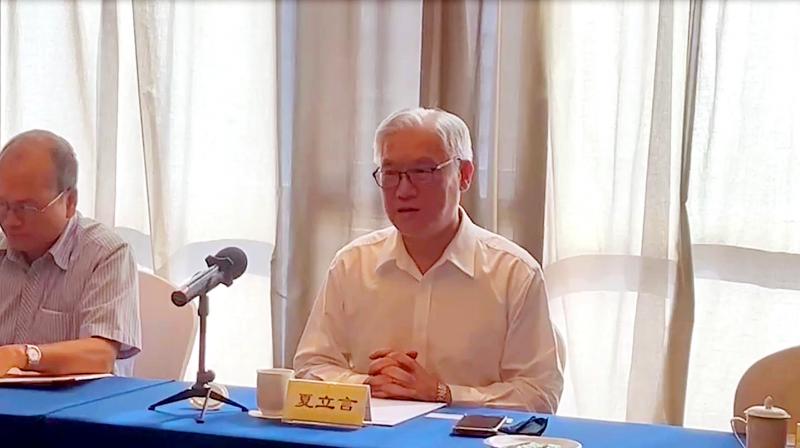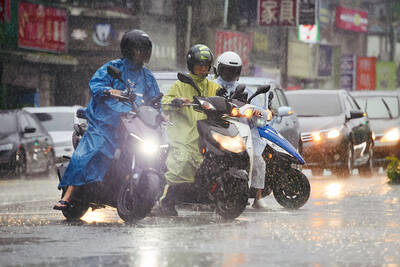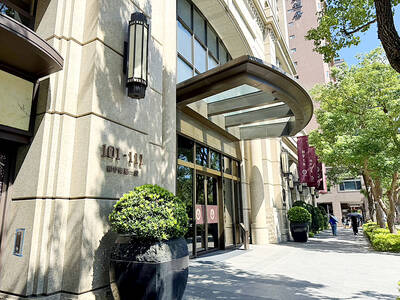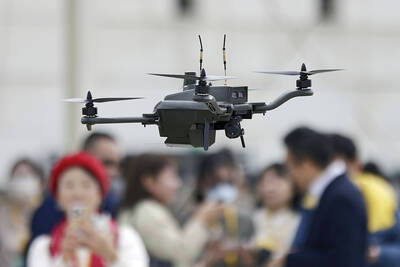A delegation to China led by Chinese Nationalist Party (KMT) Vice Chairman Andrew Hsia (夏立言) sparked controversy over the weekend amid speculation that they might meet with top Chinese officials today.
It is rumored that the delegation has a “hidden itinerary,” which includes meeting Taiwan Affairs Office Minister Liu Jieyi (劉結一) and Association for Relations Across the Taiwan Straits Chairman Zhang Zhijun (張志軍).
The KMT has said that the group would not meet with top Chinese officials or discuss political issues during the visit.

Photo provided by the KMT
KMT Chairman Eric Chu (朱立倫) yesterday said that the goal of the visit is to solve problems related to Taiwanese businesspeople, adding that he has not heard about a hidden itinerary.
The KMT mentioned to the Mainland Affairs Council (MAC) before the trip that the group might meet with Liu and other officials, but did not specify a time or place, said a government official who asked to remain anonymous.
The MAC had tried dissuading the KMT delegation from visiting China amid Beijing’s military exercises around Taiwan and economic sanctions against the nation, the official added.
Hsia’s delegation arrived in China on Aug. 10, with some KMT members calling the timing of the visit improper, as it came shortly after China on Aug. 4 began live-fire drills in waters around Taiwan. The military exercises were in response US House of Representatives Speaker Nancy Pelosi’s Aug. 2 to 3 visit to Taipei.
The KMT Culture and Communications Committee yesterday said in a statement that the delegation on Saturday completed their 10-day COVID-19 quarantine.
That night, the group dined with Xiamen officials and Xiamen Taiwanese Businessmen Association chairman Wu Chia-ying (吳家瑩), it said, adding that they held a forum to share ideas with Taiwanese businesspeople yesterday.
The statement said that Hsia had asked Xiamen officials to reopen the “small three links” to allow people-to-people exchanges across the Taiwan Strait, which were suspended in February 2020 due to the COVID-19 pandemic.
The “small three links” are the ferry services connecting China’s Fujian Province with Penghu, Kinmen and Lienchiang counties.
The trip was planned because some Taiwanese businesspeople hoped to meet KMT members, as they had not visited China for years, Hsia said.
KMT Taipei mayoral candidate Chiang Wan-an (蔣萬安) yesterday urged Hsia to clearly state his stance against China’s drills and make the itinerary transparent.
Additional reporting by Tsai Si-pei

The combined effect of the monsoon, the outer rim of Typhoon Fengshen and a low-pressure system is expected to bring significant rainfall this week to various parts of the nation, the Central Weather Administration (CWA) said. The heaviest rain is expected to occur today and tomorrow, with torrential rain expected in Keelung’s north coast, Yilan and the mountainous regions of Taipei and New Taipei City, the CWA said. Rivers could rise rapidly, and residents should stay away from riverbanks and avoid going to the mountains or engaging in water activities, it said. Scattered showers are expected today in central and

COOPERATION: Taiwan is aligning closely with US strategic objectives on various matters, including China’s rare earths restrictions, the Ministry of Foreign Affairs said Taiwan could deal with China’s tightened export controls on rare earth metals by turning to “urban mining,” a researcher said yesterday. Rare earth metals, which are used in semiconductors and other electronic components, could be recovered from industrial or electronic waste to reduce reliance on imports, National Cheng Kung University Department of Resources Engineering professor Lee Cheng-han (李政翰) said. Despite their name, rare earth elements are not actually rare — their abundance in the Earth’s crust is relatively high, but they are dispersed, making extraction and refining energy-intensive and environmentally damaging, he said, adding that many countries have opted to

FORCED LABOR: A US court listed three Taiwanese and nine firms based in Taiwan in its indictment, with eight of the companies registered at the same address Nine companies registered in Taiwan, as well as three Taiwanese, on Tuesday were named by the US Department of the Treasury’s Office of Foreign Assets Control (OFAC) as Specially Designated Nationals (SDNs) as a result of a US federal court indictment. The indictment unsealed at the federal court in Brooklyn, New York, said that Chen Zhi (陳志), a dual Cambodian-British national, is being indicted for fraud conspiracy, money laundering and overseeing Prince Holding Group’s forced-labor scam camps in Cambodia. At its peak, the company allegedly made US$30 million per day, court documents showed. The US government has seized Chen’s noncustodial wallet, which contains

SUPPLY CHAIN: Taiwan’s advantages in the drone industry include rapid production capacity that is independent of Chinese-made parts, the economic ministry said The Executive Yuan yesterday approved plans to invest NT$44.2 billion (US$1.44 billion) into domestic production of uncrewed aerial vehicles over the next six years, bringing Taiwan’s output value to more than NT$40 billion by 2030 and making the nation Asia’s democratic hub for the drone supply chain. The proposed budget has NT$33.8 billion in new allocations and NT$10.43 billion in existing funds, the Ministry of Economic Affairs said. Under the new development program, the public sector would purchase nearly 100,000 drones, of which 50,898 would be for civil and government use, while 48,750 would be for national defense, it said. The Ministry of